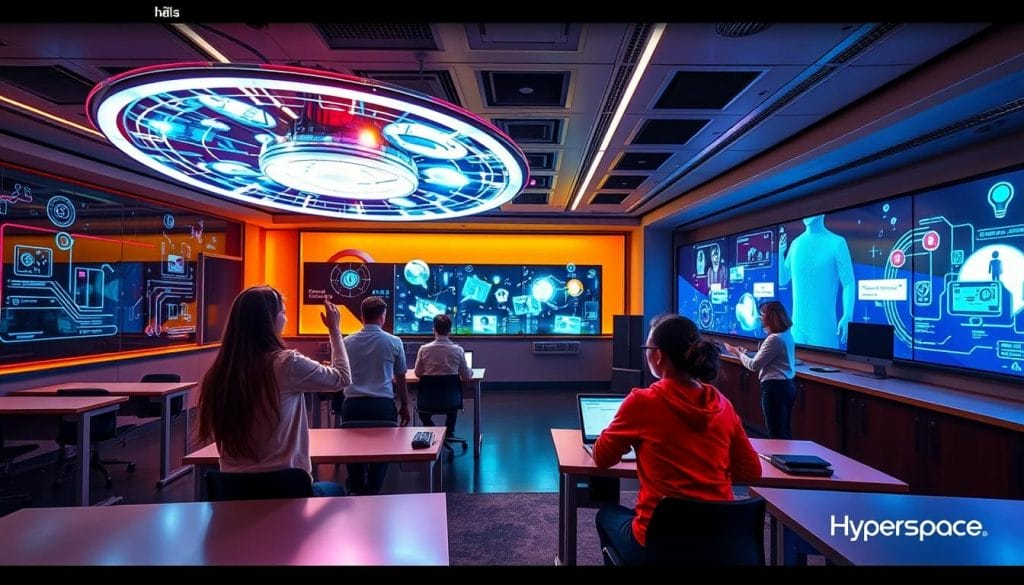A new technology is changing how we learn soft skills in AI: dynamic gesture recognition. This tech lets AI training simulations understand and react to our gestures. It makes virtual learning feel more real and interactive.
As more jobs go digital, knowing how to communicate well is key. Dynamic gesture recognition in AI training helps bridge the gap between old-school learning and today’s tech world.
Key Takeaways
- Dynamic gesture recognition makes AI soft skills training more real and interactive.
- This tech lets systems understand and respond to our body language, making interactions feel more natural.
- It solves problems in virtual settings, when our hands are busy, and in remote, risky places.
- As we head towards an AI future, gesture recognition will be key for better human-computer interaction and innovation.
- Hyperspace offers AI solutions for soft skills training, self-paced learning, and interactive role-playing. It features AI avatars that interact naturally and adapt to gestures.
Understanding Dynamic Gesture Recognition in AI

Technology keeps getting better, and so does virtual reality simulations. Nonverbal communication analysis is key to making these experiences better. At the core of this progress is dynamic gesture recognition. It’s an AI tech that can spot and understand human gestures very well.
What is Dynamic Gesture Recognition?
Dynamic gesture recognition uses machine learning and sensors to track human movements. It’s different from static gestures because it looks at movements over time. This makes human-computer interaction more expressive and nuanced.
Importance in Communication
In work settings, getting gestures right is very important. It helps with touchless systems in healthcare, immersive retail experiences, and defense communication. AI can better understand gestures, making work smoother and more collaborative.
How It Works in Training Simulations
Dynamic gesture recognition has changed how we train for soft skills. It uses AI to create real virtual reality simulations. These simulations help people practice their body language in a safe space.
| Key Gesture Recognition Statistics | Accuracy Rates |
|---|---|
| Proposed three-stream hybrid model | 98.35% average accuracy |
| Lightweight, dual-path background erasing DPCNN model for sign language recognition | 99.52% total accuracy, 0.997 Macro-F1 score |
| Multi-head convolutional network with image and hand features | 98.98% accuracy |
| Two-path depth-aware attention network model | 93.53% test accuracy |
These numbers show how far dynamic gesture recognition has come. It’s making virtual reality simulations better for training and development.
“Gesture control technology has evolved significantly from its start in gaming with Microsoft’s Kinect for Xbox 360 in 2010.”
The Role of AI in Soft Skills Development

Artificial intelligence (AI) is changing how companies train their workers. It makes learning more personal and fun. AI systems tailor training to fit each person’s needs and how they learn best.
Enhancing Learning Experiences
AI uses immersive learning environments and multimodal interfaces to improve soft skills training. It makes virtual reality (VR) simulations more personal by adjusting them based on how users act. Natural Language Processing (NLP) lets users talk to virtual worlds naturally, making learning smooth.
Personalization of Training
In virtual classrooms, AI tutors help students with their questions. They give personalized advice and support. This makes learning better for everyone, including those learning new languages.
Incorporating Real-World Scenarios
AI helps create simulations that feel like real life. These simulations use real gestures and emotions. They help learners practice their skills in a safe way, getting ready for real work situations.
AI is a big step forward in training soft skills. It helps companies create better learning experiences. As technology grows, AI’s role in training will become even more important.
Benefits of Using Gesture Recognition in Training
Gesture recognition technology in AI training brings many benefits. It uses behavioral analytics and interactive role-playing with autonomous AI avatars. This makes training more immersive and engaging, helping employees learn and grow.
Improved Engagement and Retention
Gesture recognition makes virtual training more natural and easy. It keeps learners involved, helping them remember what they learn better.
Immediate Feedback Mechanisms
It analyzes gestures and movements right away. This means learners get feedback and tips quickly. They can improve their skills on the spot.
Realistic Practice Environments
Training becomes more real with gesture recognition. Learners practice in virtual settings that feel like real life. This helps them develop skills safely and effectively.
| Feature | Benefit |
|---|---|
| Hands-free Interaction | Enhances engagement and natural movements |
| Immediate Feedback | Enables real-time skill refinement |
| Realistic Simulations | Provides authentic practice environments |
Adding gesture recognition to AI training makes learning better. It’s more engaging, responsive, and realistic. This leads to better skills and knowledge for employees.
“Gesture recognition has transformed our training programs, allowing our employees to fully immerse themselves in realistic simulations and receive immediate feedback on their performance.”
Integrating Gesture Recognition into Training Programs
Adding gesture recognition to training can make learning better and more fun. It’s important to know what technology you need, how to use it well, and how to check if it works. This way, you can make your training more engaging and effective.
Key Technology Requirements
Good gesture recognition needs strong tech. You’ll need cameras to see hand and body movements, smart algorithms to understand gestures, and fast data processing. Choosing the right tech for your needs is key for the best results.
Best Practices for Implementation
To use gesture recognition well, follow some important steps. Pick the right models for your needs, make sure processing is fast, and train on lots of data. This helps avoid mistakes and makes the tech work better.
Measuring Effectiveness
It’s important to see how well gesture recognition works. Use tools in your learning management system to track how learners do. Also, ask for feedback to learn how to make things better.
By focusing on the tech needs, using it right, and checking its success, you can make the most of gesture recognition. It helps create learning that’s fun, fits each learner, and prepares them for the future.
Examples of Dynamic Gesture Recognition in Action
Dynamic gesture recognition is changing how we train and learn in many fields. It’s used in corporate training and educational experiences. This technology opens up new ways to learn and helps both companies and individuals.
Case Studies in Corporate Training
HSBC, a top financial institution, uses virtual reality (VR) with dynamic gesture recognition in their training. They create scenarios for cross-cultural communication. This lets employees practice their body language and nonverbal cues.
The accuracy of recognizing 14 gestures in these sessions was 97.28%. This shows how effective AI-enhanced training can be.
Educational Institutions Utilizing AI
Dynamic gesture recognition is also changing education. Medical schools use AI-powered VR for hands-on training. This gives students real-world experience.
A dataset called UWB-gestures helps improve gesture-based learning. It uses impulse radar sensors to track hand gestures.
Success Stories from Participants
Many have seen the positive effects of dynamic gesture recognition in training. A study showed it makes learning more engaging and skills easier to pick up. It also helps learners feel more confident in using what they’ve learned.
These examples show the huge impact of dynamic gesture recognition. It combines virtual reality, AI, and gesture-based learning. This makes learning essential skills more effective than ever before.
Challenges and Solutions in Gesture Recognition
AI-powered gesture recognition is becoming more common. But, it faces several challenges. One big issue is understanding complex movements. People do gestures differently because of their body type and habits. AI needs to learn these variations to get it right.
Another problem is recognizing complex gestures. These gestures involve detailed movements. AI systems struggle to accurately recognize these. Also, gestures can mean different things in different cultures. AI must learn these cultural differences to avoid mistakes.
There’s also a need to build trust in AI training. People worry about privacy and how AI makes decisions. It’s important to make users understand and trust AI for it to work well.
Ensuring Inclusivity in Training
To make gesture recognition training inclusive, we need diverse datasets. These datasets should show a wide range of abilities, cultures, and ways of communicating. This helps reduce bias mitigation and ensures AI can recognize gestures from various cultural sensitivity and accessibility in AI training.
Also, having humans check and monitor AI systems helps. This way, we can catch cultural nuances that AI might miss. By combining AI and human insight, we can make gesture recognition more inclusive and effective.
“Ensuring inclusivity in gesture recognition training is not just a technical challenge, but a critical step in creating AI that meets everyone’s needs.”
In summary, solving gesture recognition challenges requires a detailed approach. This includes testing for bias, monitoring AI, and adding human oversight. By tackling these issues, we can make AI-powered gesture recognition more inclusive and accessible.
Future Trends in AI Soft Skills Training
The field of AI is growing fast, bringing new changes to soft skills training. Gesture recognition technology is getting better, thanks to AI. This means we’ll see more creative and flexible training scenarios that challenge learners in new ways.
Advancements in Gesture Recognition Technology
AI and learning algorithms are making gesture recognition systems smarter. They can now understand small body movements and facial expressions better. This makes training more real and engaging, letting learners interact with digital worlds in a natural way.
Predictions for User Experience
AI training is getting more personal and tailored to each learner. Generative AI creates unique training scenarios based on what each person needs. With advanced sensors, virtual training will feel even more real, mixing the digital and physical worlds.
The Evolving Landscape of AI Training
AI training is changing, with more use of generative AI and adaptive learning. We’ll see better mixing of physical and virtual training. This will make training more fun, effective, and affordable for everyone. It’s a big step towards preparing people for a changing world.
Measuring Success in AI-Enhanced Training
It’s key to check how well AI training works. We use data to see if it’s improving skills. This helps make training better over time.
Performance Metrics to Consider
Important signs of success include how engaged learners are, how much skills improve, and how fast they finish. Watching these helps improve training to fit what learners need.
Participant Feedback and Evaluation
What learners say is very important. Surveys and groups help us see if training is good. This feedback helps make training even better.
Long-Term Impact on Skill Development
It’s important to see how skills last over time. We track how well skills are used in real life. This shows if training is making a real difference.
Using data to check training helps improve it. This way, training gets better, and learners get a great experience. It helps develop important skills like data-driven assessment, continuous improvement, and skill transfer.
“The true measure of success in AI-enhanced training is not just immediate skill gains, but the lasting impact on workforce capabilities and organizational performance.”
Conclusion: The Future of Soft Skills Training
The future of soft skills training is all about digital transformation and AI. New tech like dynamic gesture recognition and AI-enhanced training opens up new ways to learn. It makes learning more personal, fun, and effective.
As companies grow and change, using these technologies is key. It helps them stay ahead and meet new challenges.
AI is also making learning a continuous journey. It keeps up with new skills and what each person needs to learn. This means workers can stay sharp and ready for anything.
Adding gesture recognition to soft skills training could change everything. It makes learning more natural and engaging. This leads to better learning, remembering, and using important skills in real life.
As technology gets better, so will soft skills training. It will help people and teams succeed in our fast-changing digital world.
FAQ
Q: What is dynamic gesture recognition in AI soft skills training simulations?
A: Dynamic gesture recognition is a new tech that lets AI systems get human gestures. It makes virtual interactions better by adding voice, touch, and gestures. This tech changes how we learn soft skills by making training more real and interactive.
Q: How does dynamic gesture recognition work in training simulations?
A: It uses AI, computer vision, and sensors to track human movements. This lets AI training environments understand and react to gestures. It makes learning feel more natural and easy.
Q: What are the benefits of using gesture recognition in soft skills training?
A: It offers many benefits like hands-free control and better accessibility. It makes learning more fun and effective by giving instant feedback. AI avatars that can adapt to gestures make training even better.
Q: What are the key considerations for integrating gesture recognition into training programs?
A: To add gesture recognition, you need to plan well. Choose the right cameras, algorithms, and data processing. Make sure it works in real-time and assess how well it works.
Q: How are organizations successfully implementing dynamic gesture recognition in training?
A: Many sectors are using it well. For example, HSBC uses VR for soft skills training. Schools use AI and VR for personalized learning, like in medical training.
Q: What are the challenges and solutions in gesture recognition for training?
A: Challenges include understanding complex movements and cultural differences. Solutions are testing for bias and using human oversight. This helps AI catch cultural nuances it might miss.
Q: What are the future trends in AI soft skills training with gesture recognition?
A: Future trends include better AI for understanding gestures and emotions. We’ll see more immersive and personalized training. AI will create unique scenarios and challenges, making learning more engaging.
Q: How can the success of AI-enhanced training with gesture recognition be measured?
A: Success is measured by looking at engagement, skill improvement, and how fast people finish. Feedback from learners is key to improving training. We also need to see how well skills transfer to real life.





